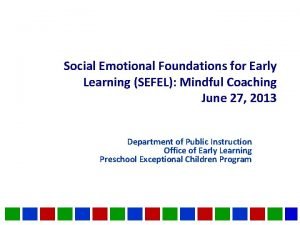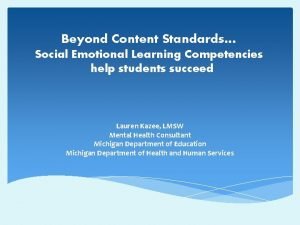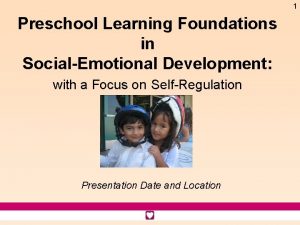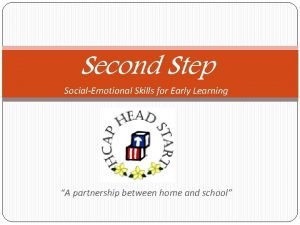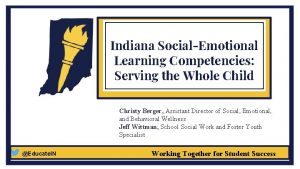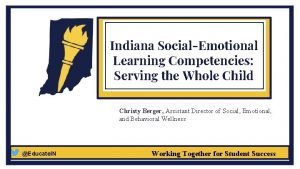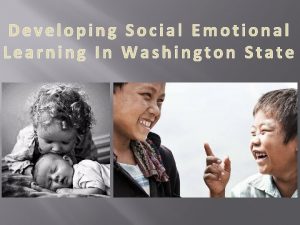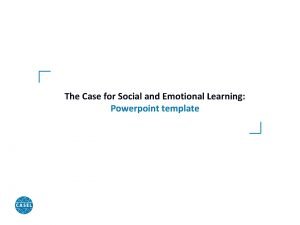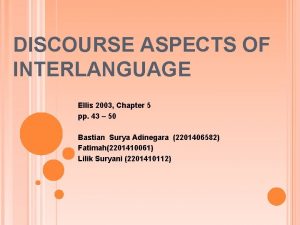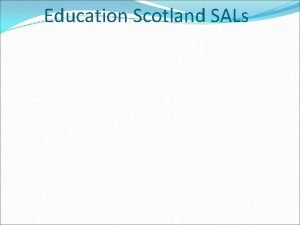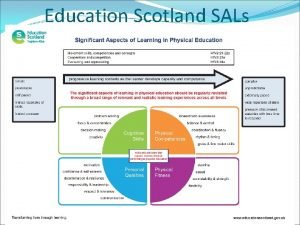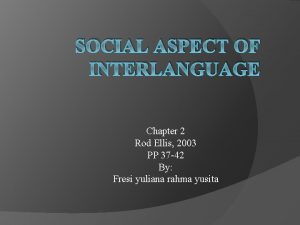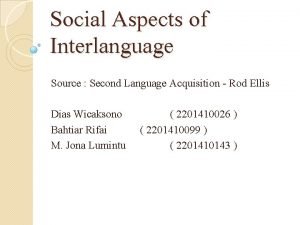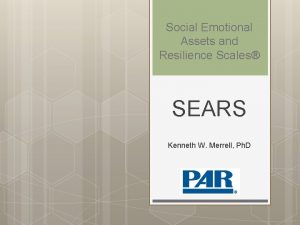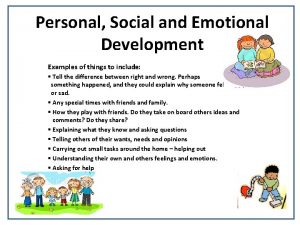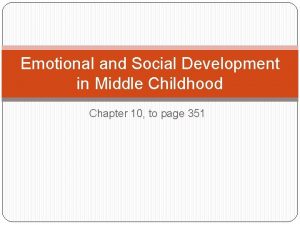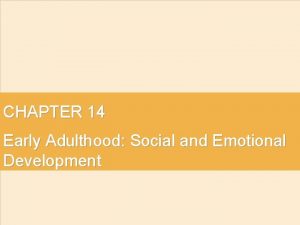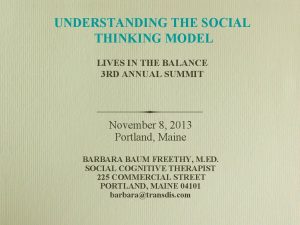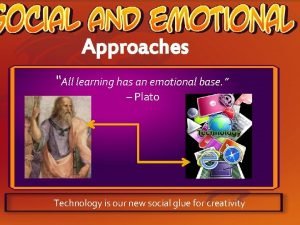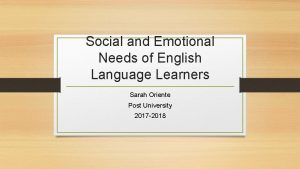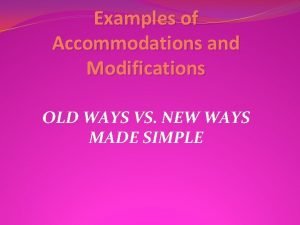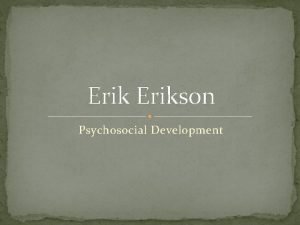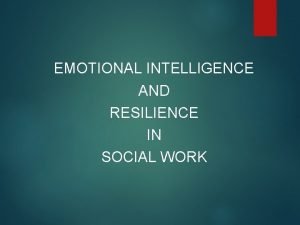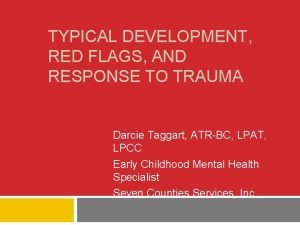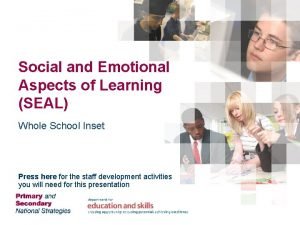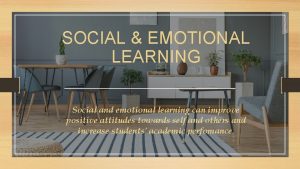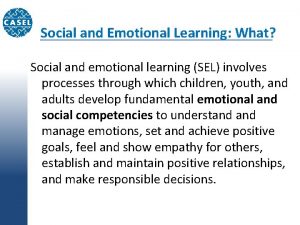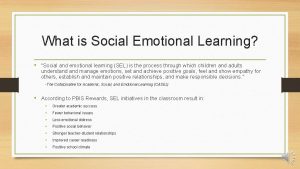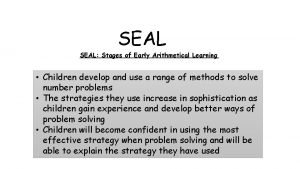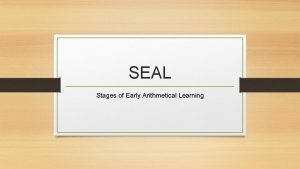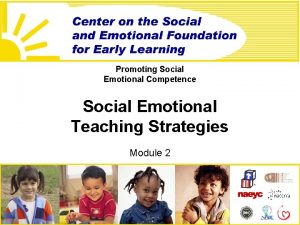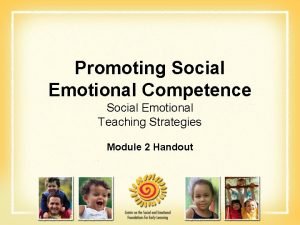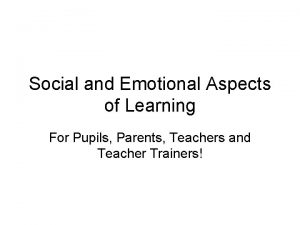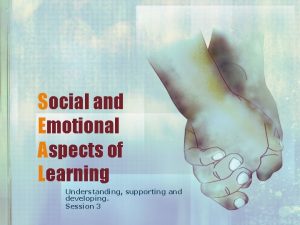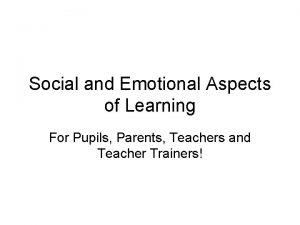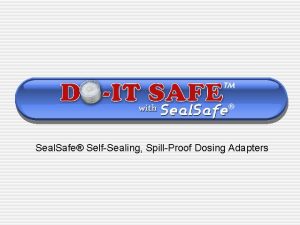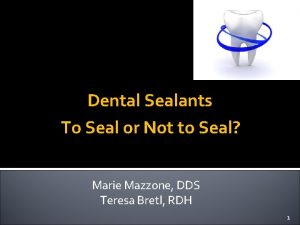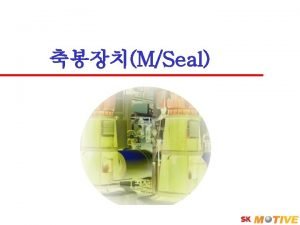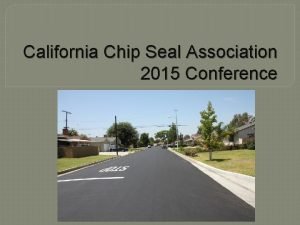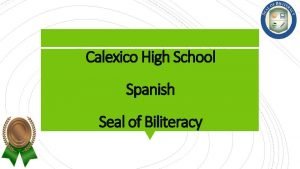Social and Emotional Aspects of Learning SEAL the





















































- Slides: 53

Social and Emotional Aspects of Learning (SEAL) & the Global Dimension CPD Materials on www. sealgd. org. uk Developed by Clive Belgeonne & Nickey Brown Development Education Centre South Yorkshire (DECSY) clive@decsy. org. uk / nickey@decsy. org. uk www. sealgd. org. uk

SEAL-GD CPD Session Introductory Circle Time activity Context of 21 st Century Learning Why SEAL (Social and Emotional Aspects of Learning)? Why is SEAL imporant? Why SEAL and the Global Dimension? Why / what is the Global Dimension? How does the Global Dimension relate to teaching and learning? What is SEAL-GD? Example of SEAL-GD approach to teaching materials Suggested Carousel of CPD activities / Single group activity Final thoughts

Circle Time 1 Change places if. . . (this sentence applies to you) You ate breakfast today You came here by public transport You have taught about anti-bullying You have taught about anti-racism You have taught social and emotional learning You were encouraged to develop emotional intelligence in your formal education You were taught to develop empathy You think empathy can be taught You teach the global dimension You know what the Millennium Development Goals are You have taught about the MDGs

Circle Time: 2. Sentence completion (Listen-No comments- Pass if want) One of my favourite foods is… One of my favourite films is… Empathy education is… The last government introduced social and emotional learning because… Many primary schools are using SEAL because… Fewer secondary schools are using SEAL because… Some teachers find teaching social and emotional learning difficult because… The global dimension to SEAL is… The global dimension is important because… One thing I want to get out of today’s training is…

Circle Time: 3. Open Forum You are now free to discuss / comment on anything anyone has said or what we have learned during this activity Circle time Ensures that each participant gets a chance to contribute and feel valued Develops interpersonal skills Strengthens relationships Enhances self-confidence Is fun. A typical structured sequence is: 1. Change places (if…. . ) 2. Sentence completion (Listen – No comments – Pass if you want to) 3. Open Forum www. antibullying. net/circletimeinfo. htm www. circletime. co. uk

21 st century learning We are the people we’ve been waiting for… www. youtube. com/watch? v=VRi 8_f. Xz 1 D 8 (3 min clip) What is the world like today? (Brainstorm) (6 min clip) Do you think this view of current education and what’s actually needed in the 21 st century is valid? What are the implications for teacher training and professional practice?

Why teach global? Stimulus clip: young person learning from out of school experience http: //www. youtube. com/watch? v=Crgzp. Pv. Jxm. Q What sort of knowledge and understanding, skills / competences and values and attitudes do young people need to have / develop to learn and live in the globalised society of the 21 st century?

21 st century schools “The world is changing fast: many of today’s most popular graduate jobs did not exist 20 years ago. It will continue to change fast and unpredictably, so today’s young people will need to be able to learn and re-train, think and work in teams and to be flexible, adaptable and creative. They also need to develop a sense of responsibility for themselves, for their health, for their environment, and for their society. They need to develop respect and understanding for those from different backgrounds, and the confidence and skills to make a positive contribution to their community. ” (Your child, your schools, our future: building a 21 st century schools system, DCSF, 2009)

The social and emotional aspects of learning. Adapted from Daniel Goleman’s five domains

Why SEAL? Sound evidence that work on emotional and social competence and wellbeing has a wide range of educational and social benefits, including: greater educational and work success improved behaviour increased inclusion improved learning greater social cohesion increased social capital improvements to mental health. What Works in Developing Children’s Emotional and Social Competence and Wellbeing? Katherine Weare and Gay Gray, University of Southampton 2003

What works in SEAL? Whole school approach is vital Coherence, teamwork and a multi-professional approach at national, LEA and school level Initiatives need to start early, target early and take a long term developmental approach Need to focus on staff social and emotional needs as well as pupils In general, an environment that enhances competence and wellbeing is one that fosters: warm relationships encourages participation develops pupil and teacher autonomy fosters clarity about boundaries, rules and positive expectations. (Ibid. )

Key Findings from the Research into SEAL implementation A consistently important quality was having a ‘whole-school universal’ approach to SEAL, including: Engagement of all staff in the school's SEAL strategy Cross-school programme of SEAL learning opportunities for all pupils Integrated approach to SEAL, behaviour, and well-being Delegation of SEAL responsibilities to all staff within a clear management structure. Social and emotional aspects of learning in schools: Contributions to improving attainment, behaviour, and attendance A report by Dr Robin Banerjee, School of Psychology, University of Sussex July 2010

Key Findings from the Research into SEAL implementation Schools that were perceived by their pupils and staff to have a more positive social and emotional ethos were also found to have: more positive pupil experiences of peer interaction better Ofsted ratings for Behaviour lower levels of Persistent Absence higher attainment in Key Stage 2 SATs and GCSEs. Social and emotional aspects of learning in schools: Contributions to improving attainment, behaviour, and attendance. A report by Dr Robin Banerjee, School of Psychology, University of Sussex July 2010

Higher levels of emotional, behavioural, social, and school wellbeing are linked to academic achievement Children with higher levels of emotional, behavioural, social, and school wellbeing, on average, have higher levels of academic achievement and are more engaged in school, both concurrently and in later years. Children with better emotional wellbeing make more progress in primary school and are more engaged in secondary school. Children with better attention skills experience greater progress across the four key stages of schooling in England. Those who are engaged in less troublesome behaviour also make more progress and are more engaged in secondary school. Children who are bullied are less engaged in primary school, whereas those with positive friendships are more engaged in secondary school. -As children move through the school system, emotional and behavioural wellbeing become more important in explaining school engagement, while demographic and other characteristics become less important. Relationships between emotional, behavioural, social, and school wellbeing and later educational outcomes are generally similar for children and adolescents, regardless of their gender and parents’ educational level. DFE Funded report Dec 2012

Schools promoting health and wellbeing The majority of the important work that schools do is not as a result of government prescription � for example intervening early and offering additional support to pupils who need it, protecting pupils from harm, and working with their local communities. Good schools play a vital role as promoters of health and wellbeing in the local community and have always had good pastoral systems. They understand well the connections between pupils�physical and mental health, their safety, and their educational achievement. They create an ethos focused on achievement for all, where additional support is offered early to those who need it, and where the right connections are made to health, social care and other professionals who can help pupils overcome whatever barriers to learning are in their way. Good schools work with parents, community organisations and local agencies to create a healthy, safe and respectful environment in school, after school, and on the way to and from school. Good teachers instil an ethos where aspiration is the best reason for children to avoid harmful behaviour. The Importance of Teaching: the Schools White Paper, Df. E 2010 (pages 28 -29): 2. 48

If you believe in it, do it Supporting pupils�health and wellbeing is something we are committed to at Culloden Primary School � because this is the right thing to do. We don’� t need the government to tell us that we should be doing this, or how we should do it. � Bill Holledge, head teacher of Culloden primary school. The Importance of Teaching: The Schools White Paper, Df. E 2010 (pages 28 -29) 2. 48

SMSC (Ofsted 2013) Overall effectiveness 84. An important aspect of the overall effectiveness judgement is a consideration of how well the school contributes to the promotion of the pupils’ spiritual, moral, social and cultural development. Spiritual, moral, social and cultural development 85. All schools should be promoting pupils’ spiritual, moral, social and cultural (SMSC) development and suitably preparing pupils for life. However, there is no need to present a detailed analysis in the report of the school’s promotion of each of the four components of pupils’ SMSC development. 86. Inspectors should consider the climate and ethos of the school and what effect this has on enabling pupils to grow and flourish, become confident individuals, and appreciate their own worth and that of others. In considering how well the school promotes pupils’ SMSC, inspectors should take into account the impact of the range of opportunities provided for young people to develop their self esteem and confidence, which might occur both within the classroom, in terms of: teaching that encourages participation, creativity, reflection and independence; assessment and feedback that values pupils’ work and/or effort; and activities that develop teamwork, leadership skills and self-reliance.

Proposed curriculum aims 1. Satisfy economic needs 2. Appreciate national cultures (while recognising diversity and encouraging responsible citizenship) 3. Provide opportunities for participation in a broad range of educational experiences 4. Support personal development and empowerment 5. Promote understanding of sustainability in the stewardship of resources locally, nationally and globally Framework for National Curriculum Dec. 2011

SEAL Curriculum Primary: Secondary: New Beginnings Introductory Theme Y 7 Getting on & Falling Out (Say No to Bullying) Learning to be Together (SS, E) Going for Goals Good to be Me Keep On Learning (M) Learning about me (MF, SA) Relationships Changes Anti-bullying

Why SEAL and the Global Dimension? “The problem is that no clear link has yet been made between the Global Dimensions approach and the SEAL materials. This constitutes a lost opportunity for joined-up thinking amongst different government departments. While SEAL has very little material of a global nature amongst its resources, similarly Global Dimensions does not specifically aim to encourage social and emotional learning through the resources that it features. The two could bring a lot of synergy if combined well. ” You Are Therefore I Am: How Empathy Education Can Create Social Change , Roman Krznaric Oxfam 2008 “The global dimension is the missing element of SEAL” Deb Michel (former SEAL National Strategy lead & member of DECSY National Consultancy Group)

Why a global dimension? 1. New secondary curriculum includes the cross-curriculum dimension ‘The global dimension and sustainable development. ’ 2. “The curriculum should enable young people to view the world from many different perspectives and help them to understand how international events affect them locally. ” (QCDA ‘World of primary learning’) 3. “We may need to act locally but we must be prepared to think nationally and indeed globally, especially when there is a diminishing sense of national identity, the interconnectedness of the fates of nations is so dramatically apparent and the sustainability of the world’s ecosystem hangs in the balance. ” (Cambridge Primary Review) 4. “From whichever point one starts and however one defines it, a global dimension in 21 st century education is essential. ” (Ibid)

Young people and global learning 78% think it is important that schools help pupils understand what people can do to make the world a better place. 19% have not had the opportunity to discuss news stories from around the world at all in school 42% believe that what they do in their daily life affects people in other countries. 72% of pupils who have thought about news stories from around the world from different points of view at school say they try to do things to make the world a better place, compared to only 49% of pupils who have not done this at school. 82% of young people think that it is important for schools to help pupils get on well with people of different backgrounds. 50% of young people think it is a good idea to have people of different backgrounds living together in the same country. (Ipsos/MORI Research for DEA, 2008)

The importance of Global Learning • Global learning creates agency around climate change, reducing by half the proportion of people who feel that it is pointless to take personal action on this issue. • Learning about global issues greatly increases the proportion of the public who support the principle of overseas aid. • Ensuring that all schools offer global learning is vital if we are to nurture a socially responsible, outward-looking populace. • There is a very high level of public support for the idea that all members of society should have the opportunity to learn about global issues The impact of global learning on public attitudes and behaviours towards international development and sustainability IPSOS/MORI for DEA 2010

Support for Global Learning Research with school pupils (Ipsos MORI, 2008) highlights that over threequarters (78%) think it is important that schools help pupils to understand what people can do to make the world a better place. Research with teachers (Ipsos MORI, 2009) found that the vast majority of teachers in England see learning about global issues as an important aspect of teaching in schools: 94% feel that schools should prepare pupils to deal with a fast-changing and globalised world. Research amongst wider society (Ipsos MORI, 2010) finds that almost nine in ten (86%) of the British public agree that learning about global issues in school is crucial if these issues are to be tackled in future. Research with parents (You. Gov, 2011) shows that the overwhelming majority of parents of school-age children think it is important that schools teach about global issues such as environmental sustainability (84% of parents) and international poverty (73%). Think Global and Oxfam response to National Curriculum Review 2011 www. think-global. org. uk

What is the global dimension? “The global dimension explores what connects us to the rest of the world. It enables learners to engage with complex global issues and explore the links between their own lives and people, places and issues throughout the world. . . It helps learners to imagine different futures and the role they can play in creating a fair and sustainable world. ” QCDA Global Dimension in Action http: //globaldimension. org. uk/pages/8444


How? Ways of engaging and relating: Learning and teaching approaches that are: active participatory democratic inclusive critical experiential empathic dialogical Ways of engaging need to consider and encourage informed and ethical action beyond the classroom. ethical action (Clive Belgeonne. Teaching the global dimension: A Handbook for Teacher Education, 2009. )

How? Ways of thinking and knowing: Making local to global connections + Acknowledging and appreciating a diverse range of perspectives (Ibid. ) “We see the world as ‘we’ are, not as ‘it’ is; because it is the ‘I’ behind the ‘eye’ that does the seeing. ” (Anais Nin)

Eight key concepts of the global dimension www. globaldimension. org. uk

5 Broad Social & Emotional Aspects of Learning (SEAL) Self-awareness Managing feelings Motivation Empathy Social Skills

Self-awareness Managing feelings Motivation Empathy Social Skills

Other Self Global Dimension Adapted from Andreotti et al 2007 World

SEAL-GD Primary Learning Outcomes Primary SEAL Learning Outcomes & Global Dimension Learning Outcomes I can set a challenge or goal, imagine or visualise how I would like our world to be and thinking ahead and considering the consequences. set a challenge or goal, thinking ahead and considering the consequences for myself, others and the environment and I can follow this through. Global Dimension Learning Outcomes I consider probable and preferable futures, and how to achieve the latter. I have the motivation and commitment to take action that will contribute to a more just world.

SEAL-GD Primary Learning Outcomes I know that feelings, thoughts and behaviour are linked. I can imagine how I would like our world to be and set a challenge or goal, thinking ahead and considering the consequences for myself, others and the environment. I can recognise the feelings of others. I value diversity and respect the thoughts, feelings, beliefs and values of all people and understand that people are who they are because of their background and experiences, language, place, religion, traditions etc. I know that people’s identity affects their opinions and perspectives of themselves, others and the world. I feel that I belong to and am valued in my class, school, community and the wider world and that my views and opinions are listened to and valued. I know that there are different types of power (e. g. Economic, political, physical, social). I understand some of the reasons why conflicts occur, that conflict is natural & that the outcome can be creative or destructive to people, place and the environment.

Global Dimension and Global Citizenship explained in ONE MINUTE! ONE MINUTE www. globalcommunity. org/flash/wombat. shtml


The Four Goals of Anti-Bias Education L. Derman-Sparks/A. B. C. Taskforce* Goal One: Nurture every child’s construction of knowledge, confident self identity and group identity. Goal Two: Promote each child’s comfortable, empathetic interaction with people from diverse backgrounds. Goal Three: Foster each child’s critical thinking about bias. Goal Four: Cultivate each child’s ability to stand up for herself or himself and for others in the face of bias. *Anti-Bias Curriculum Taskforce

Kid Other www. sealgd. org. uk – Primary > Say no to bullying > Story

Kid Other Why do we like to feel part of a group? What does it feel like to be shut of a group? Why do people who are different get picked on? What can we do when we meet people who are different from us? (from www. sealgd. org. uk – Primary, Say No To Bullying)

Possible Carousel of activities Group starter: Rights activity (in Primary, Rights Green do rounds 1 & 2) Carousel: Co-operative Squares (Going for Millennium Development Goals = Primary and Secondary versions) Refugee facts (in CPD section) / Emergencies & Disasters 2 (Primary, main activity) Journey to Safety Game (in Primary, Refugees 2)

Single group activity Going for Millennium Development Goals (Primary and Secondary versions) Includes: Co-operative Squares Photo activity Interactive MDGs powerpoint activity Board Game

Evaluating learning Whole-school SEAL and the Global Dimension audit: do at beginning and end of school year. Pupil self-evaluation questionnaire: do before and after SEAL -GD Learning Opportunity or beginning and end of school year. CPD self-evaluation questionnaire: do before and after SEALGD CPD session. Download these from CPD section of website under Evaluation

SEAL-GD Project Training Impact Over 200 participants self-evaluated on a scale of 1 (Low) to 5 (High) before and after our training sessions on areas to do with confidence and understanding of SEAL-GD and moved an average of about 2 points up the scale

SEAL-GD Training Evaluation Comments: “The best training I’ve been on in YEARS!” (Secondary teacher, Sheffield. November 2010) “Very thought-provoking and potentially radical and important for education in the UK” (School Improvement Adviser. November 2010) “Excellent course, well delivered with a good variety of activities. ” (Primary Headteacher, Cambridge. January 2011) "An excellent day. Very useful for my school. I can see SEAL-GD as a helpful structure through which to integrate our work on P 4 C, Fair trade, Sustainability. " (Primary Headteacher) "Very inspirational. . . I can't wait to try out SEAL-GD with my class" (Primary Assistant Head) "This is the most relevant course I have attended for years. . . I am very excited. " (SEN School Curriculum Leader)

SEAL-GD External Evaluation Extracts: The impact on schools involved in the SEAL and the Global Dimension project has been "profound" according to external evaluation: Teachers: All participating teachers have gained one or more of the following attributes, and most have gained many of them: Greater understanding of the global dimension in education and how it can relate to various areas of the curriculum. Greater understanding of development issues and the Millennium Development Goals. Greater understanding of how to introduce the global dimension and development issues to their SEAL teaching. Greater confidence to introduce the global dimension to their teaching generally. Greater awareness of different pedagogical approaches that are especially valuable for teaching and learning about SEAL and the global dimension. Pupils: Teachers report that the project materials and approaches improve the learning skills of young people and improve their affective skills in relation to development issues SEAL and the Global Dimension project: External Evaluators Report, Bob Hirst, March 2011

Learning requires emotional engagement. Only then do certain chemicals, such as dopamine and adrenaline, get released in our brains, and initiate chemical processes that lead to the modification of synapses. Without modification of synapses, no learning takes place, hence there is no learning without emotional engagement. Herbert Puchta discussing Romantic Understanding, Kieran Egan, professor of education at Simon Fraser University in British Columbia www. guardian. co. uk/education/2011/jan/11/tefl 1

Information, emotion, values, action There is mounting evidence that facts play only a partial role in shaping people’s judgment. Emotion is often far more important. . . It is increasingly apparent that our collective decisions are based importantly upon a set of factors that often lie beyond conscious awareness, and which are informed in important part by emotion – in particular, dominant cultural values, which are tied to emotion Common Cause: The Case for Working with our Cultural Values, Tom Crompton, WWF-UK 2010

Medicine Wheel We are all in a state of flux between: Mental Physical Emotional Spiritual Need balance between them

The importance of hope Lost generation? www. youtube. com/watch? v=42 E 2 f. AWM 6 r. A

Sources of hope in troubled times The natural world – a source of beauty, wonder and inspiration which ever renews itself and ever refreshes the heart and mind Other people’s lives – the way in which both ordinary and extraordinary people manage difficult life situations with dignity Collective struggles – groups in the past and present who have fought to achieve the equality and justice that is rightfully theirs Visionaries – those who offer visions of an Earth transformed and who work to help bring this about in different ways Relationships – being loved by partners, friends and family, which nourishes and sustains us in our lives Faith and belief – which may be spiritual or political and which offers a framework of meaning in both good times and bad A sense of self – being aware of one’s self-worth and secure in one’s own identity, which leads to a sense of connectedness and belonging Human creativity – the constant awe-inspiring upwelling of music, poetry and the arts, an essential element of the human condition Mentors and colleagues – at work and at home, who offer inspiration by their deeds and encouragement with their words Humour – seeing the funny side of things, being able to laugh in adversity, having fun, celebrating together Roots – links with the past, history, previous generations, ancestors, the need to honour continuity David Hicks Sustainable Schools, Sustainable Futures WWF 2012

www. sealgd. org. uk clive@ decsy. org. uk nickey@ decsy. org. uk

References: Books / documents Alexander, R. Children, their World, their Education: Final report and recommendations of the Cambridge Primary Review. Routledge, 2010 Banerjee, R Social and emotional aspects of learning in schools: Contributions to improving attainment, behaviour, and attendance. University of Sussex July 2010 http: //www. sussex. ac. uk/Users/robinb/SEALtracker. pdf Belgeonne, C. Teaching the Global Dimension: A Handbook for Teacher Education, DEP, 2009 Childhood Wellbeing Research Centre Impact of Pupil Behaviour and Wellbeing on Educational Outcomes DFE 2012 https: //www. education. gov. uk/publications/RSG/All. Publications/Page 1/DFE-RR 253 Crompton, T Common Cause: The Case for Working with our Cultural Values, WWF-UK 2010 http: //valuesandframes. org DEA , Our Global Future: How can education meet the challenge of change? Young People’s Experiences of Global Learning, An Ipsos MORI Research Study on behalf of DEA 2008 http: //www. think-global. org. uk/resources/research. asp DEA The impact of global learning on public attitudes and behaviours towards international development and sustainability An Ipsos MORI Research Study on behalf of DEA 20 (web address as for DEA above) DCSF Your child, your schools, our future: building a 21 st century schools system, 2009 https: //www. education. gov. uk/publications/standard/_arc_SOP/Page 5/DCSF-01133 -2009 Df. E The importance of Teaching: The Schools White Paper, Df. E 2010 Df. E The Framework for the National Curriculum - A report by the Expert Panel for the National Curriculum review 2011 Derman-Sparks, Louise Goals and Teaching Guidelines for Anti-Bias Education with Young Children 2007 Goleman, Daniel Emotional Intelligence: Why It Can Matter More Than IQ 1996 Bantam Books. Hicks, David Sustainable Schools, Sustainable Futures WWF 2012 Krznaric, Roman You Are Therefore I Am: How Empathy Education Can Create Social Change , Oxfam 2008 www. romankrznaric. com/Empathy. htm Ofsted: Subsidiary guidance - Supporting the inspection of maintained schools and academies from January 2013 QCA, Global Dimension in Action, 2007 http: //globaldimension. org. uk/pages/8444 Think Global and Oxfam Response to National Curriculum Review 2011 Weare, Katherine and Gray, Gay What Works in Developing Children’s Emotional and Social Competence and Wellbeing? University of Southampton 2003

References: Websites Cambridge Primary Review www. primaryreview. org. uk Centre for Wise Education (includes updated links to SEAL materials) www. wiseeducation. org. uk Circle Time www. antibullying. net/circletimeinfo. htm www. circletime. co. uk Global community www. globalcommunity. org/flash/wombat. shtml Global Dimension www. globaldimension. org. uk SEAL and the Global Dimension www. sealgd. org. uk SEAL National Strategy - Primary (now archived) http: //webarchive. nationalarchives. gov. uk/20110202093118/http: //nationalstrategies. stan dards. dcsf. gov. uk/primary/behaviourattendanceandseal/primaryseal SEAL National Strategy - Secondary (now archived) http: //webarchive. nationalarchives. gov. uk/20110202093118/http: //nationalstrategies. standar ds. dcsf. gov. uk/secondary/behaviourattendanceandseal/secondaryseal Teaching for a Better World www. teaching 4 abetterworld. co. uk We are the people movie www. wearethepeoplemovie. com
 Sefel training
Sefel training Social emotional learning standards michigan
Social emotional learning standards michigan Preschool learning foundations volume 1
Preschool learning foundations volume 1 Second step social emotional skills for early learning
Second step social emotional skills for early learning Social emotional learning standards nj
Social emotional learning standards nj Idoe sel lesson plans
Idoe sel lesson plans Https://moodler.doe.in.gov/
Https://moodler.doe.in.gov/ Social emotional learning washington state
Social emotional learning washington state Social emotional learning powerpoint template
Social emotional learning powerpoint template Ellis 2003
Ellis 2003 Sals physical education
Sals physical education What are significant aspects of learning
What are significant aspects of learning Stylistic continuum
Stylistic continuum Stylistic continuum
Stylistic continuum Undelies
Undelies Cuadro comparativo entre e-learning b-learning y m-learning
Cuadro comparativo entre e-learning b-learning y m-learning Social emotional assets and resilience scales
Social emotional assets and resilience scales Fictional character examples
Fictional character examples Middle childhood emotional development
Middle childhood emotional development Middle age
Middle age Social development early adulthood
Social development early adulthood Social and emotional wellbeing framework
Social and emotional wellbeing framework Socioemotional development in late adulthood
Socioemotional development in late adulthood Social thinking social learning tree
Social thinking social learning tree All learning has an emotional base
All learning has an emotional base Objectives of emotional intelligence
Objectives of emotional intelligence Apa itu social thinking
Apa itu social thinking Social thinking social influence social relations
Social thinking social influence social relations Social emotional needs of ell students
Social emotional needs of ell students Social emotional present level of performance examples
Social emotional present level of performance examples Autonomy vs shame and doubt example
Autonomy vs shame and doubt example What is emotional resilience in social work
What is emotional resilience in social work Social emotional observation checklist
Social emotional observation checklist Hình ảnh bộ gõ cơ thể búng tay
Hình ảnh bộ gõ cơ thể búng tay Bổ thể
Bổ thể Tỉ lệ cơ thể trẻ em
Tỉ lệ cơ thể trẻ em Chó sói
Chó sói Chụp phim tư thế worms-breton
Chụp phim tư thế worms-breton Hát lên người ơi alleluia
Hát lên người ơi alleluia Môn thể thao bắt đầu bằng chữ đua
Môn thể thao bắt đầu bằng chữ đua Thế nào là hệ số cao nhất
Thế nào là hệ số cao nhất Các châu lục và đại dương trên thế giới
Các châu lục và đại dương trên thế giới Công thức tính thế năng
Công thức tính thế năng Trời xanh đây là của chúng ta thể thơ
Trời xanh đây là của chúng ta thể thơ Cách giải mật thư tọa độ
Cách giải mật thư tọa độ Phép trừ bù
Phép trừ bù độ dài liên kết
độ dài liên kết Các châu lục và đại dương trên thế giới
Các châu lục và đại dương trên thế giới Thể thơ truyền thống
Thể thơ truyền thống Quá trình desamine hóa có thể tạo ra
Quá trình desamine hóa có thể tạo ra Một số thể thơ truyền thống
Một số thể thơ truyền thống Bàn tay mà dây bẩn
Bàn tay mà dây bẩn Vẽ hình chiếu vuông góc của vật thể sau
Vẽ hình chiếu vuông góc của vật thể sau
